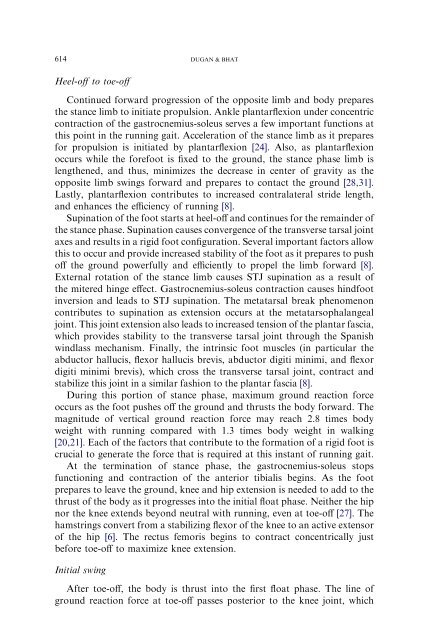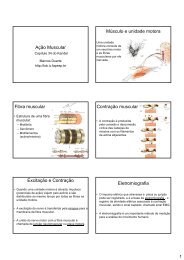Biomechanics and Analysis of Running Gait - De Motu
Biomechanics and Analysis of Running Gait - De Motu
Biomechanics and Analysis of Running Gait - De Motu
Create successful ePaper yourself
Turn your PDF publications into a flip-book with our unique Google optimized e-Paper software.
614 DUGAN & BHAT<br />
Heel-<strong>of</strong>f to toe-<strong>of</strong>f<br />
Continued forward progression <strong>of</strong> the opposite limb <strong>and</strong> body prepares<br />
the stance limb to initiate propulsion. Ankle plantarflexion under concentric<br />
contraction <strong>of</strong> the gastrocnemius-soleus serves a few important functions at<br />
this point in the running gait. Acceleration <strong>of</strong> the stance limb as it prepares<br />
for propulsion is initiated by plantarflexion [24]. Also, as plantarflexion<br />
occurs while the forefoot is fixed to the ground, the stance phase limb is<br />
lengthened, <strong>and</strong> thus, minimizes the decrease in center <strong>of</strong> gravity as the<br />
opposite limb swings forward <strong>and</strong> prepares to contact the ground [28,31].<br />
Lastly, plantarflexion contributes to increased contralateral stride length,<br />
<strong>and</strong> enhances the efficiency <strong>of</strong> running [8].<br />
Supination <strong>of</strong> the foot starts at heel-<strong>of</strong>f <strong>and</strong> continues for the remainder <strong>of</strong><br />
the stance phase. Supination causes convergence <strong>of</strong> the transverse tarsal joint<br />
axes <strong>and</strong> results in a rigid foot configuration. Several important factors allow<br />
this to occur <strong>and</strong> provide increased stability <strong>of</strong> the foot as it prepares to push<br />
<strong>of</strong>f the ground powerfully <strong>and</strong> efficiently to propel the limb forward [8].<br />
External rotation <strong>of</strong> the stance limb causes STJ supination as a result <strong>of</strong><br />
the mitered hinge effect. Gastrocnemius-soleus contraction causes hindfoot<br />
inversion <strong>and</strong> leads to STJ supination. The metatarsal break phenomenon<br />
contributes to supination as extension occurs at the metatarsophalangeal<br />
joint. This joint extension also leads to increased tension <strong>of</strong> the plantar fascia,<br />
which provides stability to the transverse tarsal joint through the Spanish<br />
windlass mechanism. Finally, the intrinsic foot muscles (in particular the<br />
abductor hallucis, flexor hallucis brevis, abductor digiti minimi, <strong>and</strong> flexor<br />
digiti minimi brevis), which cross the transverse tarsal joint, contract <strong>and</strong><br />
stabilize this joint in a similar fashion to the plantar fascia [8].<br />
During this portion <strong>of</strong> stance phase, maximum ground reaction force<br />
occurs as the foot pushes <strong>of</strong>f the ground <strong>and</strong> thrusts the body forward. The<br />
magnitude <strong>of</strong> vertical ground reaction force may reach 2.8 times body<br />
weight with running compared with 1.3 times body weight in walking<br />
[20,21]. Each <strong>of</strong> the factors that contribute to the formation <strong>of</strong> a rigid foot is<br />
crucial to generate the force that is required at this instant <strong>of</strong> running gait.<br />
At the termination <strong>of</strong> stance phase, the gastrocnemius-soleus stops<br />
functioning <strong>and</strong> contraction <strong>of</strong> the anterior tibialis begins. As the foot<br />
prepares to leave the ground, knee <strong>and</strong> hip extension is needed to add to the<br />
thrust <strong>of</strong> the body as it progresses into the initial float phase. Neither the hip<br />
nor the knee extends beyond neutral with running, even at toe-<strong>of</strong>f [27]. The<br />
hamstrings convert from a stabilizing flexor <strong>of</strong> the knee to an active extensor<br />
<strong>of</strong> the hip [6]. The rectus femoris begins to contract concentrically just<br />
before toe-<strong>of</strong>f to maximize knee extension.<br />
Initial swing<br />
After toe-<strong>of</strong>f, the body is thrust into the first float phase. The line <strong>of</strong><br />
ground reaction force at toe-<strong>of</strong>f passes posterior to the knee joint, which



